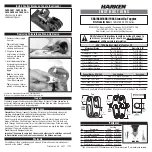SonTek – a Xylem brand
FlowTracker2 User’s Manual (January 2019)
100
i). Signal to noise ratio decreases to the electronic noise level past the boundary
and is typically about 30-70 counts,
ii). An easy way to measure the instrument noise level is to run Beam Check
when the probe is not in the water. In this case, the entire plot should show a
constant return at the instrument’s noise level.
g) When using Beam Check, it is important to understand that the output plot will
vary considerably because of the nature of acoustic scattering,
i). The shape and height of the return signal, particularly the bell curve for the
sampling volume, will show considerable variation between updates,
ii). Each of the items described above should be visible (
iii). If no sampling volume peak can be seen, try adding some fine dirt or other
material and stirring the water to increase the signal to noise ratio.
iv). If the Beam Check output differs significantly from the sample shown here,
refer to
Diagnosing Measurements with Beam Check
interpreting this data.
Beam Check Features
6.3.2
•
Sample -
Indicates the number of the transmitted pulse that is currently being
displayed on the graph and in the tabular data boxes. If real-time or previously
recorded (archived) data is being displayed, only the current sample number is
displayed.
•
Sample Averaged -
When
Averaging
has been selected, this box indicates the
number of samples that have been averaged together for the currently displayed
graph and tabular data.
•
Noise Level -
Shows the electronics noise level for the receiver of each beam. This
value is determined by the signal to noise ratio when the instrument is not receiving
any return reflections from the water. This value should match the signal to noise
ratio for the flat portion of the graph. The noise level is displayed in SNR.
•
Peak Position -
This is the location of the center of the peak for the sampling
volume for each of the receivers. The position of the peak should be about the same
for each receiver.
•
Peak Level -
This is the height of the peak for the sampling volume for each of the
receivers. This will vary depending on the amount of scattering material in the water.
•
Graph Range
(X-axis) - The graph itself shows a plot of the signal to noise ratio for
each beam as a function of range following the transmit pulse. The range portion is
shown along the graph’s X-axis and the value can be shown in centimeters, meters,
etc.
•
Graph SNR
(Y-axis) - The graph itself shows a plot of the signal to noise ratio (SNR)
for each beam as a function of range following the transmit pulse. The SNR portion
is shown along the graph’s Y-axis and the value is shown in SNR.
Summary of Contents for SonTek FlowTracker2
Page 107: ...SonTek a Xylem brand FlowTracker2 User s Manual January 2019 106 ...
Page 117: ...SonTek a Xylem brand FlowTracker2 User s Manual January 2019 116 ...
Page 196: ...SonTek a Xylem brand FlowTracker2 User s Manual January 2019 195 ii Stationary Measurement ...
Page 247: ...SonTek a Xylem brand FlowTracker2 User s Manual January 2019 246 Configuration Changes ...
Page 283: ...SonTek a Xylem brand FlowTracker2 User s Manual January 2019 282 ...
Page 300: ...SonTek a Xylem brand FlowTracker2 User s Manual January 2019 299 ...


















